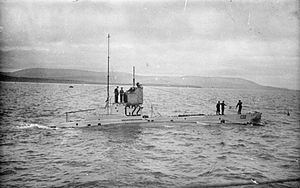Name HMS C22 Commissioned 5 May 1909 Launched 10 October 1908 Test depth 30 m | Laid down 4 February 1908 Fate Sold, 2 February 1920 Construction started 4 February 1908 Length 43 m Draft 3.51 m | |
 | ||
Displacement 290 long tons (290 t) surfaced320 long tons (330 t) submerged Builders Vickers, Barrow-in-Furness | ||
HMS C22 was one of 38 C-class submarines built for the Royal Navy in the first decade of the 20th century. The boat survived the First World War and was sold for scrap in 1920.
Contents
Design and description
The C-class boats of the 1907–08 and subsequent Naval Programmes were modified to improve their speed, both above and below the surface. The submarine had a length of 142 feet 3 inches (43.4 m) overall, a beam of 13 feet 7 inches (4.1 m) and a mean draft of 11 feet 6 inches (3.5 m). They displaced 290 long tons (290 t) on the surface and 320 long tons (330 t) submerged. The C-class submarines had a crew of two officers and fourteen ratings.
For surface running, the boats were powered by a single 12-cylinder 600-brake-horsepower (447 kW) Vickers petrol engine that drove one propeller shaft. When submerged the propeller was driven by a 300-horsepower (224 kW) electric motor. They could reach 13 knots (24 km/h; 15 mph) on the surface and 8 knots (15 km/h; 9.2 mph) underwater. On the surface, the C class had a range of 910 nautical miles (1,690 km; 1,050 mi) at 12 knots (22 km/h; 14 mph).
The boats were armed with two 18-inch (45 cm) torpedo tubes in the bow. They could carry a pair of reload torpedoes, but generally did not as they would have to remove an equal weight of fuel in compensation.
Construction and career
C22 was laid down on 4 February 1908 by Vickers at their Barrow-in-Furness shipyard, launched on 10 October, and completed on 5 May 1909. During the war, the boat was generally used for coastal defence and training in home waters. C22 was sold on 2 February 1920.
